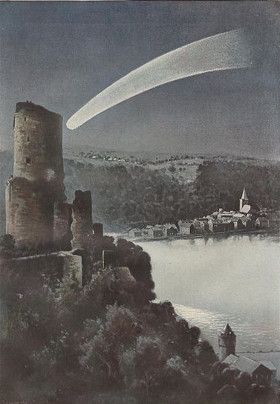
In “The Adventure of the Stockbroker’s Clerk,” Dr. Watson describes Sherlock Holmes as being as pleased as “a connoisseur who has just taken his first sip of a comet vintage.”
That’s a reference to a strange tradition in winemaking: Years in which a comet appears prior to the harvest tend to produce successful vintages:
1826 — Biela’s Comet
1832 — Biela’s Comet
1839 — Biela’s Comet
1845 — Great June Comet of 1845
1846 — Biela’s Comet
1852 — Biela’s Comet
1858 — Comet Donati
1861 — Great Comet of 1861
1874 — Comet Coggia
1985 — Halley’s Comet
1989 — Comet Okazaki-Levy-Rudenko
“For some unexplained reason, or by some strange coincidence, comet years are famous among vine-growers,” noted the New York Times in 1872. “The last comet which was fairly visible to human eyes [and that] remained blazing in the horizon for many months, until it faded slowly away, was seen in 1858, a year dear to all lovers of claret; 1846, 1832 and 1811 were all comet years, and all years of excellent wine.”
No one has even proposed a mechanism to explain how this might be, but it’s widely noted in the wine world: Critic Robert Parker awarded a perfect 100-point rating to the 1811 Château d’Yquem, and cognac makers still put stars on their labels to commemorate that exceptional year.
